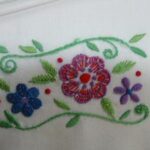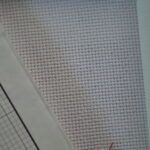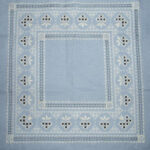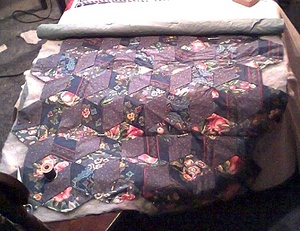I have been sewing ever since I was a child when I learned how to thread a needle and stitch two fabrics together. I have used all different kinds of needles, threads, scissors, and fabrics, and made many different types of clothing. However, I never really used a thimble until I made my first quilt back in 1986. According to Merriam-Webster, a thimble is a pitted cap or cover worn on the finger to push the needle in sewing.
When I started quilting, I was on my own. There was no Internet back then and I did not know anyone who quilted, so I relied on books. All the books I checked out at the local library were mostly text with a few drawings, all of which showed hands sewing with thimbles on them. When I went to purchase the few sewing notions I needed for quilting, I also purchased my first metal thimble. Learning to use a thimble the proper way has became a quest for me over the years and I am still not sure I am doing it right. However, I have found out a few things about thimbles that I did not know in the beginning.
One of the first things I learned was that thimbles come in different sizes. You would think this would be a “no-brainer”, but to someone who has never used a thimble, this is very helpful information. Different sized fingers need different sized thimbles.
Over the years, the standard metal thimble evolved into materials such as plastic and leather. Although, I think leather was probably used way before metal. I have even seen thimbles made from wood and bone in antique shops.
I have tried many different kinds of thimbles, some good, some not so good. Thimbles made from metal are the thimble of choice for many quilters. Being allergic to nickel and tin made using a metal thimble impossible for me, as my fingers would breakout and itch.
Plastic was my next thimble of choice, but I still could not get the hang of it. At the time, I had long fingernails and the thimble would not sit right on my finger. I later found one that had an opening in the top just for long fingernails. It worked fairly well, but it was still not a comfortable fit for me.
I next moved onto a leather thimble with elastic sides. This was a long thimble, which fit over most of my finger. It was made of soft leather and did not protect my finger very well. It also kept sliding off or twisting around my finger.
I ended up going back to the standard plastic thimble without the opening for long fingernails, since I do not have long fingernails anymore. I have seen some women quilt with a thimble on every finger, but I cannot do that. I only use one thimble on one hand to help push the needle through the multiple layers of fabric and quilt backing.
Source: Personal Experience




